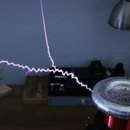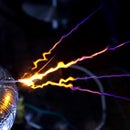Introduction: DIY Rechargeable D-Cell Battery From Aluminum Foil
There are plenty of tutorials online showing how to make homemade batteries. Sadly, most DIY batteries either have no practical use or come with a variety of hazards or complex demands. Lemon and potatoes batteries are generally incredibly weak and require perishable organic plant material as a starting point; home-brew lead-acid batteries are based on highly toxic and corrosive chemicals; and most other batteries types usually require strange chemicals like activated carbon or manganese dioxide. Well not this battery!
This battery is made from incredibly simple materials available in most homes and has enough power to run a variety of devices, especially when scaled up! This makes it an excellent emergency source of electricity when traditional batteries aren't available. Additionally, this design can be easily recharged with almost any direct current source, is remarkably lightweight, and, unlike the more common aluminum-air batteries, doesn't require airflow to run. So what are we waiting for? Let's get started!
Step 1: Gather the Supplies!
For this project, you will need the following items:
- Aluminum foil
- Salt (potassium, calcium, or sodium chloride will work, while bicarbonates, carbonates, and hydroxides won't)
- A source of a less reactive metal (tin cans or copper wire/tubing are both excellent options)
- Paper (writing paper, paper towel, and toilet paper are all viable materials)
- PVA glue (I'm using Gorilla wood glue)
- Water
These next few items are optional, but still recommended:
- 1" PVC pipe section (this will be the housing for the battery)
- Hot glue gun (for assembly)
- A multimeter (for testing)
Step 2: Design and Theory
All batteries are based on a type of chemical reaction known as a redox reaction (short for reduction-oxidation reaction). In a redox reaction, one substance is oxidized (loses an electron) while another is reduced (gains an electron). Pretty simple, right? It turns out when you separate this type of chemical reaction into two halves, you can channel the electrons that the substances exchange through a conductor and use them as electricity before they return and complete the redox reaction.
In this aluminum-metal battery, the two halves of the battery are soaked in a saline solution and separated by a special membrane that only allows sodium and chloride ions through. The aluminum on one half wants to be oxidized into solution as aluminum ions, while the copper or steel on the opposite side wants to remain out of solution as a pure metal. If the copper (or steel) side contains copper or iron ions in solution, the redox reaction will begin. The aluminum on one half of the cell will give up some of its electrons to go into solution, and the copper or steel on the other side will use up the electrons to convert the copper or iron ions in solution back into metallic copper or iron. The membrane in between the two halves allows electrons and carrier ions like sodium and chlorine to flow and balance, while keeping the copper/iron electrons away from the metallic aluminum. If the copper or iron ions make contact with the aluminum, they will be directly reduced back into copper or iron metal, and no power will flow from the battery.
When the battery is charged, the positive terminal of the DC supply is connected to the anode and the negative to the cathode. As voltage is applied, chloride ions from the solution are attracted to the anode. The copper (or iron) reacts with the chloride ions to form copper or iron chlorides, which readily dissolve into solution. This effectively recharges the cell, making it ready for another electricity-producing redox reaction cycle. However, unlike the copper or iron which is rejuvenated upon recharging, the aluminum in solution at the cathode is far too reactive to revert back into aluminum metal when the battery is charged. Instead, it will be slowly corroded away into aluminum oxides and hydroxides (as well as sodium aluminate).
Step 3: Make the Anode
The anode will be the positive side of the battery, and must be made of some metal that is less electronegative than aluminum. Copper, iron, and steel are all good candidates, due to their high abundance, although copper seems to work the best. You may be tempted to use a less reactive metal like lead or silver, but they won't perform nearly as well due to the poor solubility of their chlorides. I personally used a short length of copper pipe that I wrapped into a cylindrical shape. In the images above, I also showed that an ordinary steel can may also be turned into a functional anode. Since this is meant to be a D-sized battery, I cut the anode material down to the height of an ordinary D-cell. The diameter was slightly smaller than the inside diameter of the PVC pipe section I later used to house the battery cell.
Step 4: Make the Ion-Exchange Membrane
To make the all-important ion-exchange membrane, simply wrap the anode you just made in paper or another thin, absorbent material. Then, soak the whole unit in salt water. If you don't wish to use ordinary salt, you may also try non-sodium salt (potassium chloride) or another alkali metal chloride, nitrate, or sulfate. Calcium and magnesium salts won't work as well, and bicarbonates, carbonates, and hydroxides should be avoided since copper and iron compounds with these ions are mostly insoluble.
After soaking, coat the entire paper portion with ordinary PVA glue (Elmer's school glue and most white glues are good examples of PVA glue). This will stop most of the soluble copper/iron salts from migrating to the cathode side of the battery, where they would readily react away without producing any usable electricity. It is best if the glue is allowed to dry (at least most of the way). If you leave the glue out to dry, make sure you re-saturate the membrane with saltwater afterwards. A quicker route to curing the glue that I found was dipping the glue-coated membrane into a solution of sodium tetraborate (borax), which almost immediately polymerizes the PVA glue and helps increase its ion conductivity.
Step 5: Wrap on the Aluminum Foil Cathode
As mentioned previously, the other essential half of this battery is its aluminum cathode. This could be by far the simplest step: simply wrap the ion exchange membrane in aluminum foil and you're good to go! Just be sure the aluminum foil doesn't make contact with the copper or steel anode!
Step 6: Enclose the Battery (optional)
While the battery itself is done, it's unlikely that you want a dripping-wet, somewhat delicate battery laying around in the open. My personal solution: stick the whole thing an a section of ordinary PVC tubing. I used PVC pipe with a 1" (25mm) inner diameter and a 1.25" (31mm) outer diameter similar to a commercial D-size battery. I sealed the bottom and most of the top with hot glue, making sure to leave some of the foil cathode and metal anode exposed. I didn't fully seal the battery, since small amounts of gas tend to be formed during the charging process.
Step 7: Test It Out!
You're finally done! Now, to enjoy the fruits of your labor! Without a supply of soluble iron or copper salts on the anode side, this battery will not work, so charging the battery is our first step. You can use almost any DC current source, as long as the current isn't too high (5A seems to be the safe maximum). To charge the battery, simply connect the anode to the supply positive and the cathode to supply negative. If you're monitoring the current during charging, you'll probably notice it starts to decrease as the battery gains charge, which is a good sign that the battery is working properly. After charging, you may want to test the battery with a multimeter. Using a copper anode, I got a maximum voltage of 1.44V across my DIY battery after a modest charging cycle. The highest current I got from the battery was a whopping 1.2 amps. While this may not sound like a whole lot, this is actually exceptional for a homemade battery. For comparison, traditional lemon or potato batteries typically output only a few milliamps at best. A commercial D-cell battery can output over 5 amps of current, so this homemade battery is roughly equivalent to a moderately-used D-cell!
Although it is not shown here, I did a test in which I pitted my battery against a true 1.5V D-cell. Both batteries were used to drive a small DC motor while the input currents and motor speeds were recorded. In the end, this homemade battery performed the EXACT SAME as the commercial D-cell in this test! Not bad for aluminum foil, scrap metal, and salty glue-paper!
This battery is by no means perfect. The ion exchange membrane still allows some soluble copper salts through to the cathode side of the battery, where they react away into copper metal and insoluble copper oxides and hydroxides. Additionally, the aluminum cathode gradually deteriorates due to the caustic conditions in that half of the cell. While there is room for improvement, this battery is still very usable, and can be easily built and used by people in desperate need of electricity. By scaling this battery up and adding multiple cells in series and parallel, a very large amount of power could be produced or stored for little to no cost. The potential for this technology could be immense, especially if it is further developed. Who knows...maybe you'll be the one to develop it!




